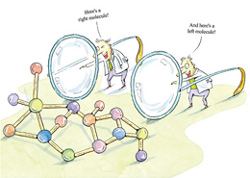Scientists are often attracted to either the very large or the very small. For Dr. Petr Kral, visiting theoretical physicist at the Weizmann Institute of Science, the fascination lies at the Lilliputian end of the spectrum. He has a longstanding interest in transport through tiny bodies - how an electron, for example, gets through a molecule attached to two electrical contacts. Recently he has attracted attention with his theoretical work on optical and frictional methods of sending electrons through nanotubes - tiny molecular cylinders - to perform specific tasks.
The prefix "nano"means one billionth. A nanotube, despite its diminutive transversal size (the tube's length is thousands of times longer than its diameter), could, in principle, be made of almost any layered material. In Kral's laser pump research, he has shown that laser beams - otherwise known as coherent light - can be used to excite electrons inside carbon nanotubes so that they move in a single direction. As the electrons make their way through the tube, they push forward movable molecules inside it.
This pumping technique could give rise to such applications as a nano pen, in which atomic "ink"(a chain of atoms) is pushed through the nanotube to write on a surface. The nano pen could also be used for biomedical purposes: By virtue of its tiny size, it could deposit molecules into an individual cell. Recently Kral suggested a scheme in which circularly polarized light could be used to rotate nanotubes with frequencies of billions of times per second - an idea that could potentially be applied in nanomotors and nanopropellors.
Separating lefts from rights
Kral, who is working in Prof. Moshe Shapiro's group at the Materials and Interfaces Department, is also looking for ways in which laser beams can be harnessed to perform practical tasks in molecules.
One particularly intriguing innovation the team is pursuing is a way of employing lasers to separate the left and right versions of a chiral molecule. Any mirror-image pair - such as our hands, ears, or feet - is said to be "chiral"(chir is Greek for "hand"). Molecules can also exhibit this kind of relationship. But left and right molecules, though similar in many respects, can exhibit very different behavior patterns. Aspartame, for example, is a sweet molecule, but its mirror molecule is bitter.
Because only one chiral form may be desired in a biological application, the lefts and rights have to be separated from each other. Theoptical separation of lefts and rights depends, according to Shapiro and Kral's theory, on their asymmetry. Molecules exist in discrete energy states called "quantum levels,"and light can be used to couple different quantum levels. But while non-chiral molecules are subject to certain "selection rules"that dictate conditions for these couplings, chiral (or asymmetric) molecules are largely free of these limitations.
This greater freedom implies that chiral molecules can theoretically be transported across a wider variety of quantum levels. Kral has devised a method, using three laser pulses, that can transfer chiral molecules either directly from one quantum level to another or via anintermediate level. The innovative technique involves a cyclical movement between levels (for example, from level 1 to level 2, from level 2 to level 3, and from level 3 back to level 1).
The next step is to separate the lefts from the rights. The cyclical excitation of molecules by lasers creates interference. The interference conditions that are generated for left and right molecules are different. This determines which molecules go to which level - lefts to 2, rights to 3,or vice versa, depending on the lasers'phases - which in turn makes the moleculesdistinguishable from one another. Once the groups have been sorted out by left and right orientation, it becomes possible to pull them apart.
Shapiro and Kral believe it might be possible to use light not only to sift out the desired versions of individual molecules but even to convert the undesirables directly and efficiently into their more beneficial counterparts. The conversion, says Kral, can be done in a few nano-seconds only by using light - a considerable improvement over all other methods attempted to date.

Prof. Shapiro's research is supported by Mr. Bram Appel, Canada; the Estate of Dr. David Salmon, UK; and the Fritz Haber Center for Physical Chemistry. He holds the Jacques Mimran Professorial Chair.
_and_Dr_Petr_Kral_Exploring_a_miniature _world.jpg)
